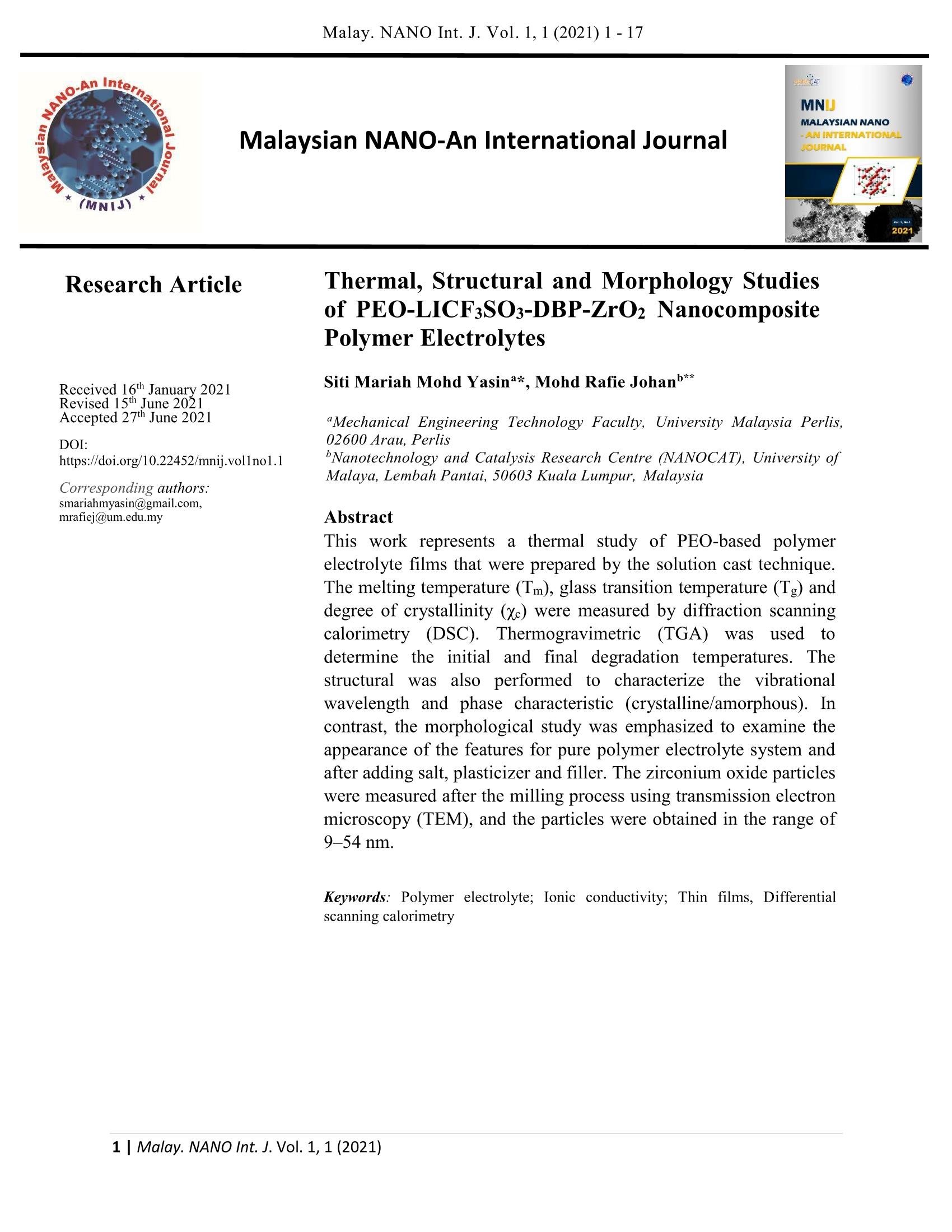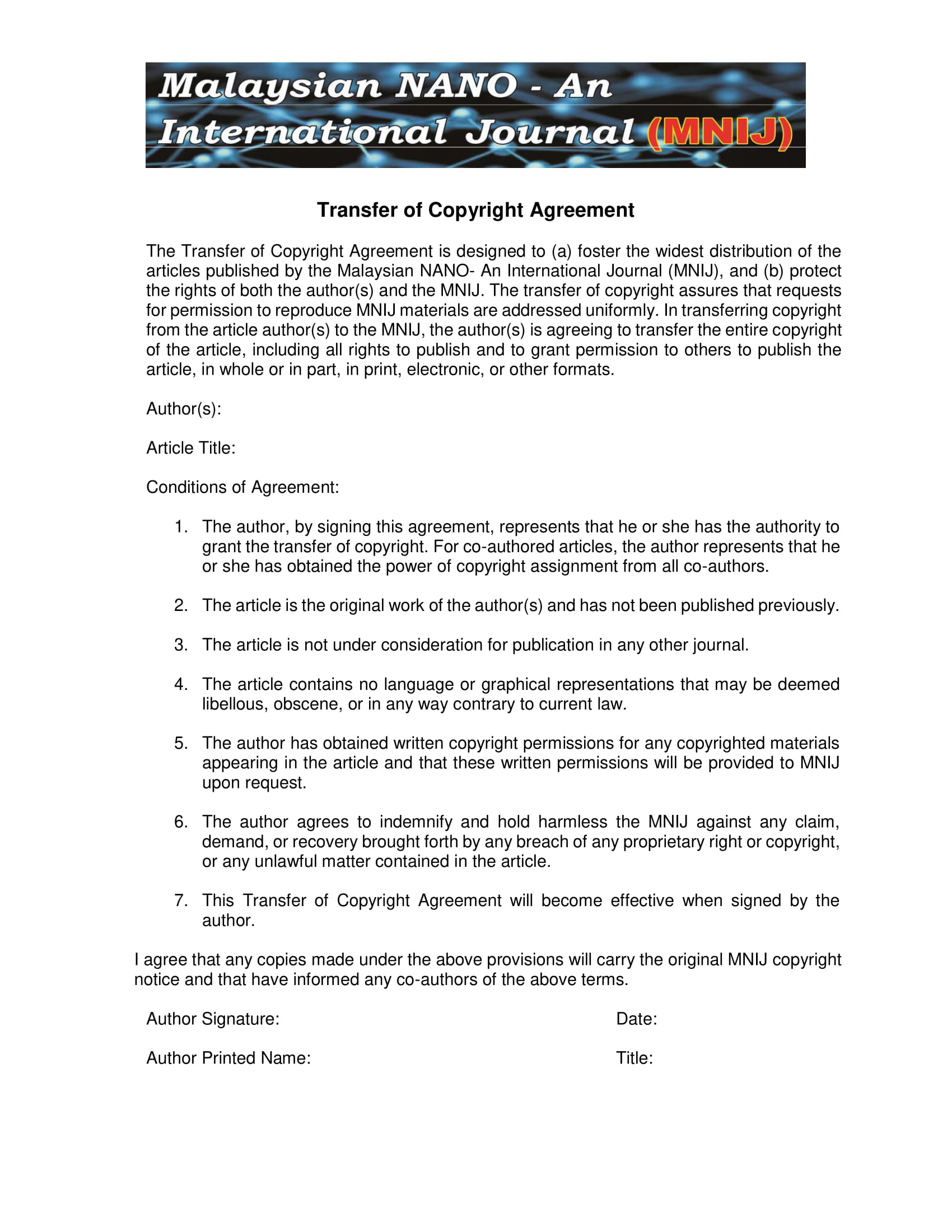Thermal, Structural and Morphology Studies of PEO-LICF3SO3-DBP-ZrO2 Nanocomposite Polymer Electrolytes
DOI:
https://doi.org/10.22452/mnij.vol1no1.1Keywords:
Polymer electrolyte, Ionic conductivity, Thin films, Differential scanning calorimetryAbstract
This work represents thermal study of PEO-based polymer electrolyte films that were prepared by the solution cast technique. The melting temperature Tm, glass transition temperature Tg and degree of crystallinity χc were measured by diffraction scanning calorimetry (DSC). Thermogravimetric (TGA) was used to determine the initial and final degradation temperatures. The structural was also performed to characterize the vibrational wavelength and phase characteristic (crystalline/amorphous). While the morphological study was emphasized to examine the features appearance for pure polymer electrolyte system as well as after addition salt, plasticizer and filler. The zirconium oxide particles were measured after the milling process by using the transmission electron microscopy (TEM), and the particles obtained in the range of 9 – 54 nanometer size.
Downloads
References
F. M. Gray. Book review: Polymer electrolytes. Royal Society of Chemistry, Cambridge. 1997; 175.
Y.T. Kim, E.S. Smootkin. The effect of plasticizers on transport and electrochemical properties of PEO-based electrolytes for lithium rechargeable batteries. Solid State Ionics. 2002;149: 29-37.
M.R. Johan, L.B. Fen. The combined effect of CuO nanofillers and DBP plasticizer on ionic conductivity enhancement in the solid polymer electrolyte PEO–LiCF3SO3. Solid state Ionics. 2010; 16: 335-338.
M. Algamir, K.M. Abraham, in G. Pistoia (Eds.), Lithium Batteries, New Materials, Developments and Perspectives. Industrial Chemistry Library. Elsevier, Amsterdam. 1994; Vol 5: 93-136.
M. Kovac, M.Gaberšček and J.Grdadolnik. The effect of plasticizer on the microstructural and electrochemical properties of a (PEO)nLiAl(SO3Cl)4 system. Electrochimica Acta. 1998; 44: 863-870.
S.M. Mohd Yasin, S. Ibrahim and M.R. Johan. Effect of zirconium oxide nanofiller and dibutyl phthalate plasticizer on ionic conductivity and optical properties of solid polymer electrolyte. The Scientific World Journal. 2014; 14: 547076.
T. Otsuka and Y. Chujo. Poly(methyl methacrylate) (PMMA)-based hybrid materials with reactive zirconium oxide nanocrystals. Polymer Journal. 2010;42,58-65.
C.J. Leo, G.V. Subba Rao and B.V.R. Chowdari. Studies on plasticized PEO-lithium triflate-ceramic filler composite electrolyte system. Solid State Ionics. 2002; 148: 159-171.
Y.W. Kim, W. Lee and BK. Choi. Relation between glass transition and melting of PEO–salt complexes. Electrochim. Acta. 2000; 45; 1473-1477.
H.M.J.C. Pitawala, M.A.K.L. Dissanayake and V.A. Seneviratne. The combined effect of Al2O3nano-fillers and EC plasticizer on ionic conductivity enhancement in the solid polymer electrolyte (PEO)9LiTf. Solid State Ionics. 2007; 178: 885-888.
V.M. Mohan, V. Raja, P.B. Bhargav, A.K. Sharma and V.V.R. Narasimha Rao. Structural, electrical and optical properties of pure and NaLaF4 doped PEO polymer electrolyte films. Journal of Polymer Resource. 2007; 14: 283-290.
S. Ibrahim, S.M. Mohd Yasin, N.M. Nee, R. Ahmad and M.R. Johan. Conductivity, thermal and infrared studies on plasticized polymer electrolytes with carbon nanotubes as filler. Journal of Non-Crystalline Solids. 2012; 358: 210-216.
M.M. Fares, J. Hacaglolu and S. Suzer. Characterization of degradation products of polyethene oxide by pyrolysis mass spectrometry. European Polymer Journal. 1994; 30: 845- 850.
T. Caykara., S. Demirci., M.S. Eroglu and O. Guven. Poly(ethylene oxide) and its blends with sodium alginate. Polymer. 2005; 46: 10750-10757.
Y. Takahashi, I. Sumita and H. Tadokoro. Structural studies of polyethers. IX. Planar zigzag modification of poly(ethylene oxide). Journal of Polymer Science: Polymer Physics Edition. 1973; 11: 2113-2122.
T. Kuila. H. Acharya, S.K. Srivastava, B.K. Samantaray and S. Kureti. Enhancing the ionic conductivity of PEO based plasticized composite polymer electrolyte by LaMnO3 nanofiller. Materials Science and Engineering. 2007; B.137: 217-224.
S.J. Wen, T.J. Richardson, D.I. Ghantous, K.A. Striebel. P.N. Ross and E.J. Cairns. FTIR characterization of PEO + LiN(CF3SO2)2 electrolytes. Journal of Electroanalytical Chemistry. 1996; 408: 113-118.
S. Ramesh, T.F. Yuen and C.J. Shen. Conductivity and FTIR studies on PEO-LiX [X: CF3SO3‾, SO42‾] polymer electrolyte. Spectrochimica Acta Part A. 2008; 69: 670-675.
S. Rajendran and T. Uma. Lithium-ion conduction in PVC–LiBF4 electrolytes gelled with PMMA. Journal of Power Sources. 2000; 88: 282-285.
A. Rohman and Y.B. Che Man. Analysis of water content in soap formulation using Fourier transform infrared (FTIR) spectroscopy. Journal of Applied Science Research. 2009; 5: 717-721.
Z. Osman and A.K. Arof. FTIR studies of chitosan acetate based polymer electrolytes. Electrochimica Acta. 2003; 48: 993-999.

Downloads
Published
How to Cite
Issue
Section
License





